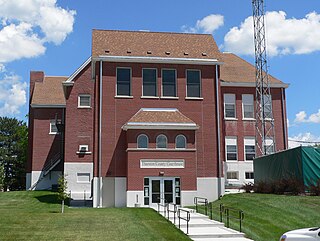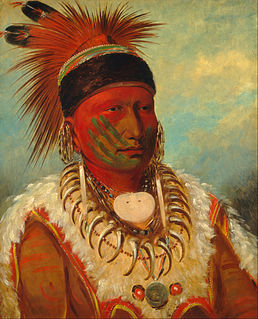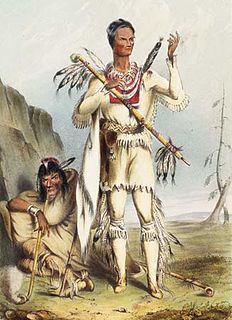See also
| This disambiguation page lists articles associated with the title Winnebago. If an internal link led you here, you may wish to change the link to point directly to the intended article. |
Winnebago can refer to:
| This disambiguation page lists articles associated with the title Winnebago. If an internal link led you here, you may wish to change the link to point directly to the intended article. |

The Black Hawk War was a brief conflict between the United States and Native Americans led by Black Hawk, a Sauk leader. The war erupted soon after Black Hawk and a group of Sauks, Meskwakis, and Kickapoos, known as the "British Band", crossed the Mississippi River, into the U.S. state of Illinois, from Iowa Indian Territory in April 1832. Black Hawk's motives were ambiguous, but he was apparently hoping to avoid bloodshed while resettling on tribal land that had been ceded to the United States in the disputed 1804 Treaty of St. Louis.
The Hocągara (Ho-Chungara) or Hocąks (Ho-Chunks) are a Siouan-speaking Indian Nation originally from Wisconsin and northern Illinois, but due to forced emigration, they are also found in Nebraska, where about half the nation now lives. They are most closely related to the Chiwere peoples, and more distantly to the Dhegiha.

Thurston County is a county in the U.S. state of Nebraska. As of the 2010 United States Census, the population was 6,940. Its county seat is Pender.

The Iowa or Ioway, known as the Báxoǰe in their own language, are a Native American Siouan people. Today, they are enrolled in either of two federally recognized tribes, the Iowa Tribe of Oklahoma and the Iowa Tribe of Kansas and Nebraska.

The Ho-Chunk, also known as Hoocąągra or Winnebago, are a Siouan-speaking Native American people whose historic territory includes parts of Wisconsin, Minnesota, Iowa, and Illinois. Today, Ho-Chunk people are enrolled in two federally recognized tribes, the Ho-Chunk Nation of Wisconsin and the Winnebago Tribe of Nebraska.
The Ho-Chunk language, also known as Winnebago, is the traditional language of the Ho-Chunk nation of Native Americans in the United States. The language is part of the Siouan language family, and is closely related to the languages of the Iowa, Missouri, and Oto.

Indigenous peoples of the Northeastern Woodlands include Native American tribes and First Nation bands residing in or originating from a cultural area encompassing the northeastern and Midwest United States and southeastern Canada. It is part of a broader grouping known as the Eastern Woodlands. The Northeastern Woodlands is divided into three major areas: the Coastal, Saint Lawrence Lowlands, and Great Lakes-Riverine zones.

Waukon Decorah, also known as Wau-kon-haw-kaw or "Snake-Skin", was a prominent Ho-Chunk (Winnebago) warrior and orator during the Winnebago War of 1827 and the Black Hawk War of 1832. Although not a hereditary chief, he emerged as a diplomatic leader in Ho-Chunk relations with the United States.
Yellow Thunder, was a chief of the Ho-Chunk tribe. He signed two treaties with the United States in which his Ho-Chunk name was given as Wa-kun-cha-koo-kah and Waun-kaun-tshaw-zee-kau.

Glory of the Morning was the first woman ever described in the written history of Wisconsin, and the only known female chief of the Hocąk (Winnebago) nation. At least one source has rendered her name as Hopokoekau, which is a corruption of Hąboguwįga, from hąp, "day"; ho-, "the time at which"; gu, "to come arriving"; -wį, an affix indicating the feminine gender; and -ga, a definite article used for personal names. The name is conventionally translated as "Glory of the Morning" or "The Coming Dawn".

Red Bird was a leader of the Winnebago Native American tribe. He was a leader in the Winnebago War of 1827 against Americans in the United States making intrusions into tribal lands for mining. He was for many years one of the most friendly and trusted of the Wisconsin Native Americans. In the late 1820s Red Bird and his followers began to grow uneasy over the encroachments of lead miners on Ho-Chunk land. The tribe had an uneasy relationship with the dominant culture's legal concepts and often continued to follow tribal practices of justice. This tension resulted in several incidents, including confrontations with Secretary of War, John C. Calhoun. One incident involved the mistaken information channeled to the tribe that two Ho-Chunk executions were conducted at Fort Snelling in 1826 for a murder they did not commit. As white miners continued to extract resources near Winnebago villages on the Rock River, the War Department sought to keep tribes from mining the same minerals, in fear that the land would become contentious. Near Prairie du Chien on June 28, 1827, Red Bird had become increasingly angered by treatment of the tribe. Encroachment on native lands, unfair incarceration, and increasing violence led to escalating tensions. Under pressure from the tribe to defend their interests, Red Bird set off with two others, Chickhonsic and Wekau ; eventually meeting a trader, John Lockwood and a former British soldier, Duncan Graham, who advised against violence. Upon arriving at the cabin of Registre Gagnier, the party was met with a friendly welcome and invited in for refreshment. Gagnier, feeling suspicious about the nature of the visit, reached for his rifle, thus setting off the following events. Chickhonsic shot Solomon Lipcap. Wekau attempted to shoot Mrs. Gagnier, but she and her son escaped and gave the alarm in Prairie du Chien.

Little Priest Tribal College is a public tribal community college in Winnebago, Nebraska. It is a member of the American Indian Higher Education Consortium and primarily supported by the Winnebago Tribe of Nebraska. It has an enrollment of 135 students, of which 90 percent are American Indian.
The Ho-Chunk Nation (Hoçak) has traditional territory located across five states in the United States. It was formerly known as the Wisconsin Winnebago Tribe, It is one of two federally recognized tribes that were once a single tribe formerly known as Winnebago. The other federally recognized tribe is the Winnebago Tribe of Nebraska. The tribe separated when its members were forcibly relocated first to a reservation in Minnesota, and later to the current reservation in Nebraska. The name Ho-Chunk comes from the word Hochungra, meaning "People of the Big Voice" or "People of the Sacred Language."

The Winnebago Tribe of Nebraska is one of two federally recognized tribes of Ho-Chunk Native Americans. The other Ho-Chunk tribe is the Ho-Chunk Nation of Wisconsin. Tribe members often refer to themselves as Hochungra - "People of the Parent Speech".

The Winnebago Council is a council of the Boy Scouts of America (#173). The Winnebago Council serves Boy Scouts, Cub Scouts, adult volunteers and Venturers in 17 counties located in North Central Iowa. Including: Black Hawk, Grundy, Butler, Franklin, Wright, Hancock, Winnebago, Worth, Cerro Gordo, Mitchell, Floyd, Bremer, Chickasaw, Howard, Winneshiek, Fayette, and Buchanan. We serve over 3,200 youth with the support of 1,600 registered volunteers and more than 150 chartered partners. The Winnebago Council also operates the Ingawanis Adventure Base near Waverly, IA as our resident Boy Scout Camp.

Native American tribes in the U.S. state of Nebraska have been Plains Indians, descendants of succeeding cultures of indigenous peoples who have occupied the area for thousands of years. More than 15 historic tribes have been identified as having lived in, hunted in, or otherwise occupied territory within the current state boundaries.
The Winnebago Reservation of the Winnebago Tribe of Nebraska is located in Thurston County, Nebraska. The tribal council offices are located in the town of Winnebago. The villages of Emerson, south of First Street, as well as Thurston, are also located on the reservation. The reservation occupies northern Thurston County, Nebraska, as well as southeastern Dixon County and Woodbury County, Iowa, and a small plot of off-reservation land of southern Craig Township in Burt County, Nebraska. The other federally recognized Winnebago tribe is Ho-Chunk Nation of Wisconsin, whose reservation is primarily in that state.
The Harvard Project on American Indian Economic Development was founded in 1987 at the John F. Kennedy School of Government, Harvard University. It administers tribal awards programs as well as providing support for students and conducting research.The Harvard Project aims to understand and foster the conditions under which sustained, self-determined social and economic development is achieved among American Indian nations through applied research and service.

American Indians of Iowa include numerous Native American tribes and prehistoric cultures that have lived in this territory for thousands of years. There has been movement both within the territory, by prehistoric cultures that descended into historic tribes, and by other historic tribes that migrated into the territory from eastern territories. In some cases they were pushed by development pressure and warfare.